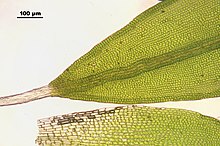Upholstery pillow moss
| Upholstery pillow moss | ||||||||||||
|---|---|---|---|---|---|---|---|---|---|---|---|---|

Upholstery pillow moss |
||||||||||||
| Systematics | ||||||||||||
|
||||||||||||
| Scientific name | ||||||||||||
| Grimmia pulvinata | ||||||||||||
| Hedw. & Sm. |
The cushion moss ( Grimmia pulvinata ) is an easily recognizable deciduous moss from the Grimmiaceae family . It is a common moss in central European cities.
features
The moss usually forms smaller, compact cushions that are blackish to blue-green and shimmer gray both when dry and when wet. The upright, 1 to 2 centimeter long stems of the gametophytes are forked.
The spirally arranged, elongated lanceolate leaves are slightly arched when dry and upright to lying flat, protruding when moist, 2 to 3 millimeters long, not wrinkled, with a wide, rolled edge and a distinct rib. Its tip is slightly blunted, and a white, long, smooth glass hair suddenly emerges from it. The cells in the middle of the leaf are round to square, with a strongly thickened wall, at the base of the leaf they are 2–4 times longer than wide.
The brownish sporophyte , 2 to 5 millimeters long, protruding from the top of the trunk and thus from the moss cushion is initially bent down, but when it is ripe it stands up. The pendulous to horizontal, brown capsule is spherical to egg-shaped and has eight to ten longitudinal ribs and sixteen, warty, red, often split teeth at their tips. The cap-shaped capsule lid is short-nibbled and lifted up by a central column. The lobed capsule hood ( kalyptra ) is also hat-shaped.
The cushion cushion moss is one of the most drought-resistant types of moss in Central Europe, it tolerates dehydration up to complete waterlessness.
Occurrence
The very common species usually grows on calcareous rocks of all kinds, of course on calcareous rocks and rock rubble, in settlements on walls and roofs, it is rarely found on trees, but never on the ground. Upholstered pillow mosses prefer sunny, dry locations at altitudes of 0 to 1000 meters.
Moss of the year 2007
The upholstery cushion moss was voted Moss of the Year 2007 by the Bryological-Lichenological Working Group . The choice is to draw attention to the physiological performance of mosses.
proof
- ↑ a b c d Dietmar Aichele, Heinz Werner Schwegler: Our moss and fern plants. An introduction to the way of life, the construction and the recognition of native mosses, ferns, bear moss and horsetail. 6th edition. Franckh, Stuttgart 1974, ISBN 3-440-02826-7 , p. 108.
- ↑ Wolfgang O. Abel: The desiccation resistance of the mosses. In: Austrian Academy of Sciences, mathematical and natural science class. Meeting reports. Department 1: Biological and Earth Sciences. Vol. 165, Issue 9/10, 1956, ISSN 0029-8808 , pp. 619-707, here p. 683, ( digital version (PDF; 6.52 MB) ).


